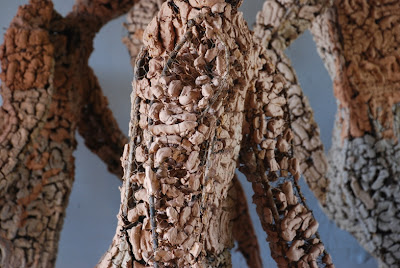
Friday, January 11, 2008
Thursday, January 10, 2008
BEHIND THE BALLOT BOX

The ballot box, a row of 8 life-sized sculptures, each of them constructed with armatures of human figures wrapped with wire-mesh upon which blobs of clay have been plastered all over with. The figures are all of different sizes, shapes and heights and are wielded to a long, narrow rectangular metal frame so that they are in a sort of queue-like formation.
What with the current state of our political unrest, the ballot box has become a symbol of oppression, intimidation, violence and deception rather than the freedom the citizen has to exercise his or her franchise. One can no longer visit the polling centers during elections these days without witnessing some of the strangest atrocities and raves of violence and political thuggery or hooliganism that occurs in the new Nigerian definition of election.
What with the current state of our political unrest, the ballot box has become a symbol of oppression, intimidation, violence and deception rather than the freedom the citizen has to exercise his or her franchise. One can no longer visit the polling centers during elections these days without witnessing some of the strangest atrocities and raves of violence and political thuggery or hooliganism that occurs in the new Nigerian definition of election.
CHOREOGRAPHY OF CLAY AND TWIGS

This assemblage consists of diverse twigs all respectively swathed in clay, each tied together and collectively arranged in a manner that shrewdly suggests crude outlines of a number of human shapes, each one a subtle visual depiction of the theatrical sequences and nuances of choreography. A clay drapery and flowing figure defines and describes the background of the work, and it synchronizes with the activities of the clayed twigs, thus forming a composition consisting of the fusion of intrinsic sculptural metaphors that delineate happiness, joy and merriment with exuberant movements
URCHINS

In the artwork, Urban Urchins, twigs of various sizes, each individual twig smeared with clay and capped with clay balls, have been stuck into respective lumps of clay. The assemblage is reminiscent of sea urchins on an ocean floor. Figuratively, an ‘urchin’ means a ‘spoilt, mischievous child’, and this is what is indirectly emphasized on, the strength of the influence emanating from primary social groups, especially youth groups or more precisely the peer group syndrome, since twigs are actually parts of a tree and can be regarded as the “child” of the parent, since they can be cultured to grow into them.
The differences in the sizes of each twig in a bunch characterize the attitude of an individual identifying him or her in a group that accepts their respective personalities and lauds their respective ideals. The artist believes that most of the social anomalies haunting the society in these recent times could be traced down to the delicate period in a child’s growth between pre-teen to adolescence, and much of the negative influences they embrace in their urban settings. He also posits that this can have an impact on the developmental trend of a society at large whether politically, economically or otherwise.
The differences in the sizes of each twig in a bunch characterize the attitude of an individual identifying him or her in a group that accepts their respective personalities and lauds their respective ideals. The artist believes that most of the social anomalies haunting the society in these recent times could be traced down to the delicate period in a child’s growth between pre-teen to adolescence, and much of the negative influences they embrace in their urban settings. He also posits that this can have an impact on the developmental trend of a society at large whether politically, economically or otherwise.





